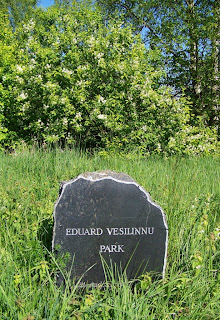Taat owned some land around Pirita and called it collectively “Lauri Talu”, or “Lauri Farm”. (How he could have known that one of his great granddaughters would be named “Laurie” is a mystery.)
One of the plots of land in Lauri Talu was on a river island, immediately behind the old cloister. Here is a 1930s aerial view of Pirita. The cloister is the ruin in the middle of the picture, and the river island is to the right and down from the cloister. You can see how the island is divided up and cultivated. Taat's piece of the island was at the tip of the island at the river bend, immediately to the right of the ruins.
When the land was given back to us in 1993 we decided to protect this little piece of land from development, and thought that the best thing we could do would be to have a long-term lease with the nuns in the new convent that was just under construction. They agreed that it would be a shame to have development on the island, and accepted the deal. By the year 2002, however, the governmental structure of Pirita had matured, and it became clear that the town would never allow this island to be developed, so we decided to deed it to the town.
But the gift had two stipulations. First, that the land would always remain public park land, and second, that the park would be named after our grandfather, Eduard Vesilind. And so it is. The stone marker is there, and the curious public has worn a path from the road to the marker. I picture Taat with a bemused expression on his face if we could have told him that his old hay field was the
-- Aarne



6 comments:
Vesilinnu?
That's the possessive form of Vesilind. In English we would use the apostrophe as in "Vesilind's Park". In Estonian you would say "Vesilinnu Park". To complicate matters, the possessive form is irregular, so if you wanted to say "Eduard's Park" it would be "Eduardi Park". Even worse, if it was "Peep's Park", in Estonian it would be "Peebu Park". Don't ask me to explain that.
Please explain that.
Would one of you Estonians please expain this to Pamela (and to me)? There has to be rule somewhere.
OK, since you asked... Before beginning the explanation, though, I'd recommend that you sit down very comfortably (use the bathroom first if you have to, so you don't have to get up in a while) and get ready for a long, deep, thorough puzzlement. :-)
As you may have already figured out, Estonian is one of the most irregular and therefore difficult languages on Earth. Once you have mastered it, French, German and all the rest seem like a breeze.
There are altogether 14 clearly differentiable cases in the Estonian language. This in itself is pretty crazy. (I think there are really about 2 in English: nominative and possessive, although they claim there to be 5.) Add to that 90 Estonian type nouns, each of which has 14 distinct cases and 15 type verbs + innumerable exceptions and you've got yourself a thorough mess.
http://www.eki.ee/dict/qs76/tyybid.html
So, basically the rule is that if you are not sure about how to use a word's 14 cases (or one of them), you either figure out or look up the type word for it, and base your usage of the word on that. And most often, as luck has it, if you are already not sure, it turns out to be an exception anyway.
For example, the type word for Vesilind ("lind" or "bird", actually), is #58, "järsk" http://www.eki.ee/cgi-bin/qs76.cgi?sona=lind
(yeah, go figure - they look nothing alike)... and of course, as luck has it, it IS marked with a "=" and "-" denoting exceptions.
I don't know how many exceptions there possibly are in Estonian, but there seem to be something along the lines of Gazillion. And for exceptions there are no rules. Otherwise the exceptions won't be exceptions, right? So some things you just have to know.
In that sense, I'm very much amused by our Liis' learning of Estonian, as she has her own clear ideas about some type words, which incidentally don't match the big fat "Õigekeelsussõnaraamat", or "Dictionary of Orthology".
Since I have probably lost you by now, I'm just going to wish you, just like Liis in English, "Goo night, sleep tight, donlettabedbugs bite!!!" as I'm turning in myself for the day.
Thanx for your gift!
Post a Comment